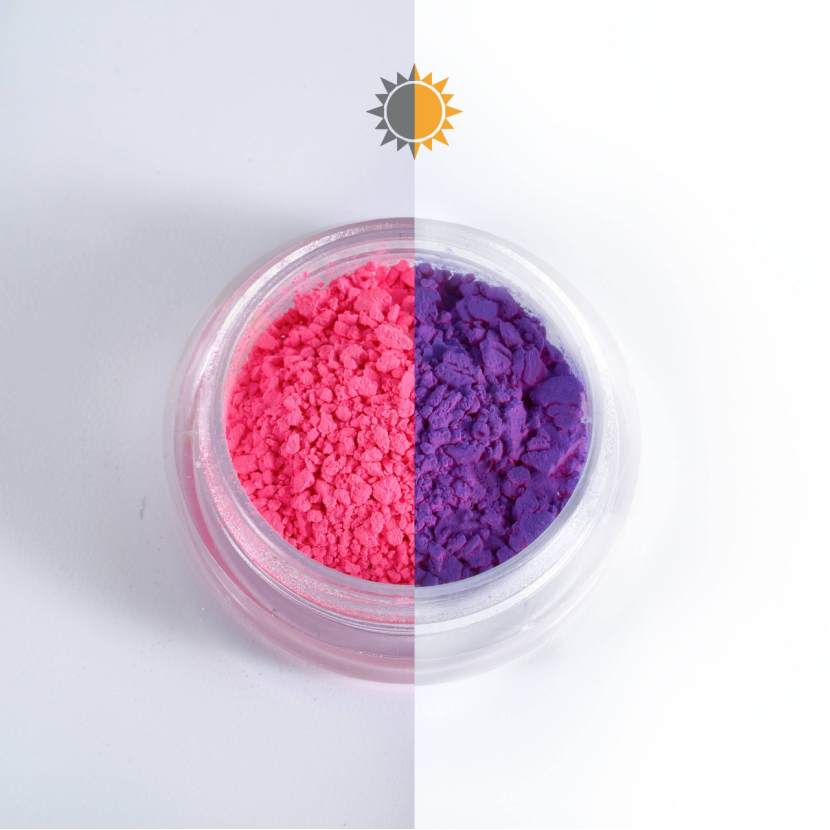
Understanding Photochromic Pigments
What Are Photochromic Pigments?
Photochromic pigments are unique compounds. They change color reversibly. UV light triggers this shift. Without UV, they’re colorless or pale. With UV, they turn vivid. This adaptability makes them popular. They’re used in consumer products. Industrial applications value them too.
How They Function
Their magic lies in molecules. UV light alters their structure. They absorb specific light wavelengths. This creates color. When UV fades, molecules revert. The original state returns. This cycle repeats. It resists wear over time. The process stays reliable.
Core Properties
These pigments offer key traits:
Reversibility: They switch states easily. This suits varied uses.
Durability: Quality pigments last. They endure many cycles.
Sensitivity: They react to UV intensity. Response is quick.
Customization: Adjust wavelengths or colors. This fits specific needs.
Applications of Photochromic Pigments in Everyday Products
Eyewear and Lenses
Photochromic pigments shine in glasses. Transition lenses use them. They darken in sunlight. This protects eyes from UV. It adds comfort. Users avoid swapping glasses. Sunglasses and prescriptions benefit. Functionality improves greatly.
Fashion and Textiles
Fashion embraces these pigments. They create lively designs. Fabrics shift patterns in sunlight. Colors change too. Sportswear loves this. Casual clothes and accessories too. Hats and bags stand out. Style meets practicality. Consumers enjoy the flair.
Consumer Goods and Packaging
Everyday items use these pigments. Toys glow with UV. Novelty items surprise users. Promotional goods draw attention. Mugs change in sunlight. Stickers react to UV. In packaging, they add beauty. They also signal light exposure. This aids transport safety.
Industrial and Commercial Uses of Photochromic Pigments
Automotive Coatings
Cars benefit from these pigments. Coatings shift with sunlight. Shades vary dynamically. This boosts visual appeal. It protects surfaces from UV. Vehicles look unique. Durability improves too. The automotive sector values this innovation.
Smart Windows and Buildings
Photochromic tech transforms windows. They adjust transparency. Sunlight intensity guides this. Energy efficiency rises. Glare drops. Indoor temperatures stabilize. No shades are needed. Building materials use it too. Sustainable designs emerge. Architecture becomes greener.
Security Printing
Security relies on these pigments. They fight counterfeiting. Passports use them. Banknotes and certificates too. UV reveals hidden features. This adds protection. Verification stays simple. Authorized users trust the system.
Creative and Artistic Uses of Photochromic Pigments
Art Installations
Artists love photochromic pigments. They create dynamic visuals. Installations change with UV light. Outdoor sculptures shift hues. Sunlight intensity drives this. Audiences are captivated. The art feels alive. It engages its environment. Reversibility ensures longevity. Displays stay vibrant over time.
Customizable Decor
Interior design transforms with these pigments. Walls change colors. Sunlight triggers this shift. Homeowners refresh spaces easily. No repainting is needed. Furniture adapts too. Decorative items shine. Lighting conditions guide aesthetics. Modern homes blend function and art. This appeals widely.
Personalized Accessories
Fashion accessories get creative. Jewelry shifts appearance. Watches and shoes do too. UV light sparks color changes. A necklace may look silver indoors. Outdoors, it’s vibrant. This mix of style and function excites users. Accessories feel personal. They stand out.
Advancements in Technology with Photochromic Pigments
Wearable Tech Integration
Wearable tech evolves with these pigments. Smartwatches use them. Fitness bands too. Straps or displays change color. UV exposure triggers this. It’s visually appealing. It’s practical too. High UV levels prompt alerts. Users know to protect skin. This blends style and safety.
UV Detection Tools
Photochromic pigments aid UV tools. They sense ultraviolet light. Devices give real-time feedback. Wearable patches show UV levels. They signal sunscreen needs. Shade becomes a priority. These tools boost health awareness. They protect users effectively.
Smart Material Trends
Smart materials are the future. Photochromic pigments lead here. They adapt to light changes. Textiles may shift patterns. Clothing adjusts to sunlight. Automotive interiors could benefit. Exteriors too. Energy efficiency improves. Sustainable solutions grow. Industries embrace this potential.

Innovative Applications of Photochromic Pigments in Nail Art
Nail Art Design
Nail artists have embraced photochromic pigments to revolutionize nail art. These pigments allow for the creation of mesmerizing nail designs that transform with changing light conditions. A simple manicure can turn into a dynamic masterpiece as the nails shift colors under UV light.
Personalized Nail Experiences
The use of photochromic pigments in nail art offers customers a highly personalized experience. Clients can choose from a wide range of color – changing combinations to match their mood, outfit, or the occasion. A person going to a beach party can opt for nails that start as a soft pastel shade indoors and transform into bright tropical colors under the sun.
Nail Art Trends
Photochromic pigment – based nail art is becoming a significant trend in the beauty industry. Social media platforms are flooded with images of stunning color – changing nails, inspiring more people to try this innovative technique. Nail salons are adding photochromic nail services to their menus, attracting customers who are looking for something new and exciting.
Frequently Asked Questions
What are creative uses for these pigments?
They enhance art installations. They customize decor. Jewelry and watches adapt. Accessories shift with light.
How do they improve wearables?
They change colors with UV. Smartwatches and bands alert users. UV protection awareness rises.
Are they used in interior design?
Yes, walls and furniture change hues. Lighting conditions drive this. It blends art and function.
What trends involve this tech?
Smart textiles adapt clothing. Automotive uses save energy. Building materials turn sustainable.
Contact Hangzhou Yayang Industrial Co., Ltd. for tailored solutions. Their expertise since 1999 delivers innovative photochromic applications!
